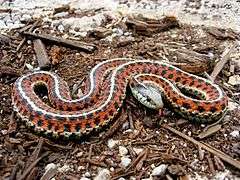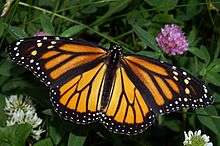Escape and radiate coevolution
Escape and radiate coevolution is a multistep process that hypothesizes that an organism under constraints from other organisms will develop new defenses, allowing it to "escape" and then "radiate" into differing species. After a novel defense has been acquired, an organism is able to escape predation and rapidly multiply into new species because of relaxed selective pressure. There are many possible mechanisms available varying between different types of organisms, however they must be novel in order for escape to allow for radiation. This theory applies to predator-prey associations, but is most often applied to plant-herbivore associations.

This form of coevolution can be complex but is essential to understanding the vast biological diversity among organisms today. Out of the many forms of coevolution, escape and radiate is most likely responsible for providing the most diversity. This is due to the nature of the "evolutionary arms race" and the continuous cycle of counter adaptations. It is a relatively new field of study and is rapidly gaining credibility. To date, there has not been a formal study published specifically for escape and radiate coevolution.
Origin of Theory
This theory originated in a paper by Ehrlich and Raven, 1964, "Butterflies and plants: a study in coevolution".[1] It outlined and laid the foundations of the concept. However, the term "escape and radiate" was not coined until Thompson's 1989 "Concepts of Coevolution".[2] The theory has not yet been fully analyzed, however, as since its origins it has grown in importance among evolutionary biologists and botanists.
Escape
In order for an organism to "escape", and then radiate into varying species it needs a mechanism to escape. These defense mechanisms vary widely and differ for different types of organisms. Plants use chemical defenses in the form of secondary metabolites or allelochemicals. These allelochemicals inhibit the growth, behavior, and health of herbivores, allowing plants to escape.[3] An example of a plant allelochemical are alkaloids that can inhibit protein synthesis in herbivores. Other forms of plant defense include mechanical defenses such as thigmonasty movements which have the plant leaves close in response to tactile stimulation. Indirect mechanisms plant include shedding of plant leaves so less leaves are available which deters herbivores, growth in locations in that are difficult to reach, and even mimicry. For organisms other than plants, examples of defense mechanisms allowing for escape include camouflage, aposematism,[4] heightened senses and physical capabilities, and even defensive behaviors such as feigning death. An example of an organism using one of these defense mechanisms is the granular poison frog which defends itself through aposematism. It is important to understand that in order for escape and radiate coevolution to occur, it is necessary that the developed defense is novel rather than previously established.
Induced defense stemming from adaptive phenotypic plasticity may help a plant defend itself against multiple enemies.[5] Phenotypic plasticity occurs when an organism undergoes an environmental change forcing a change altering its behavior, physiology, etc. These induced defenses allow for an organism to escape.
Radiate
Radiation is the evolutionary process of diversification of a single species into multiple forms. It includes the physiological and ecological diversity within a rapidly multiplying lineage.[6] There are many types of radiation including adaptive, concordant, and discordant radiation however escape and radiate coevolution does not always follow those specific types.
This eventually leads to the question, why does escape allow for radiation? Once a novel defense has been acquired, the attacking organism which had evolved adaptations that allowed it to predate is now up against a new defense that it has not yet been evolved to encounter. This gives the defending organism the advantage, and therefore time to rapidly multiply unopposed by the previously attacking organism. This ultimately leads to the physiological and ecological diversity within the rapidly multiplying lineage, hence radiation.
Importance
A full study analyzing the effects of escape and radiate coevolution has not yet been completed which hinders knowing how applicable this form of coevolution could be to other areas of study, or global concerns, only hypotheses of its effects can be made. Improved agriculture, conservation, biological diversity, and epidemiology are just some of the areas that could potentially be helped through the study of coevolution and its specific hypotheses such as escape and radiate coevolution.[7]
A theory as to why we see such vast biological diversity today may be because of escape and radiate coevolution. After the organism escapes, it then radiates into multiple species, and spreads geographically. Evidence of escape and radiate coevolution can be seen through the starburst effect in plant and herbivore clades.[8] When analyzing clades of predator-prey associations, although it varies, the starburst effect is a good indicator that escape and radiate coevolution may be occurring. Eventually this cycle must come to an end because adaptations that entail costs (allocation of resources, vulnerability to other predators) that at some point outweigh their benefits.[9]
Escape and radiate coevolution may support parallel cladogenesis, wherein plant and herbivore phylogenies might match with ancestral insects exploiting ancestral plants. This is significant because it allows researchers to hypothesize about the relationships between ancestral organisms.[10] Unfortunately, there have not yet been any known examples specifically involving escape and radiate coevolution being used for hypothesizing ancestral relationships.
Many times the organism that has "escaped" continuously undergoes selective pressure because the predator it has escaped from evolves to create another adaptation in response, causing the process to continue. These "offensive" traits developed by predators range widely. For example, herbivores can develop an adaptation that allows for improved detoxification which allow to overcome plant defenses, thus causing escape and radiate coevolution to continue. Often the term "evolutionary arms race" is used to illustrate the idea that continuous evolution is needed to maintain the same relative fitness while the two species are coevolving. This idea also ties in with the Red Queen hypothesis. Counter adaptations among two organisms through escape and radiate coevolution is a major driving force behind diversity.
Escape and radiate coevolution produces much more biological variation than other evolutionary mechanisms. For instance, cospeciation is important for diversity amongst species that share a symbiotic relationship, however this does not create nearly as much diversity in comparison to reciprocal evolutionary change due to natural selection.[11] Evidence of rapid diversification following a novel adaptation is shown through the evolution of resin and latex canal tubes in 16 different lineages of plants. Plants with resin or latex canals can easily defend themselves against insect herbivores. When lineages of canal bearing plants are compared to the lineages of canal free plants, it is apparent that canal bearing plants are far more diverse, supporting escape and radiate coevolution.[12]
Associations
Plant-herbivore

The most popular examples of escape and radiate coevolution are of plant-herbivore associations. The most classic example is of butterflies and plants outlined in Ehrlich and Raven's original paper, "Butterflies and plants: a study in coevolution.". Erlich and Raven found in 1964 that hostplants for butterflies had a wide range of chemical defenses, allowing them to escape herbivory. Butterflies who developed novel counter detoxification mechanisms against the hostplants chemical defenses were able to utilize the hostplant resources.[1] The process of stepwise adaptation and counteradaptation among the butterflies and hostplants is continuous and creates vast diversity.
Tropical trees may also escape and defend themselves. Trees growing in high light were predicted to have few chemical defenses, but rapid synchronous leaf expansion and low leaf nutritional quality during expansion. Species growing in low light have high levels of different chemical defenses, poor nutritional quality and asynchronous leaf expansion. Depending on the level of light the trees were growing in influenced the type of defenses they obtained, either chemical or through leaf expansion. The trees exposed to less light developed various chemicals to defend themselves against herbivores, a defense not utilizing light. This study was significant because it illustrates the separation between defenses and their relationship with an organism escaping and radiating into other species. Development of novel defenses does not necessarily imply that escape is possible for a species of plant if herbivores are adapting at a faster rate.[13]
Milkweed plants contain latex-filled canals which deter insect herbivores. Latex is toxic for small herbivores because it disrupts sodium and potassium levels. This has allowed for milkweeds to "escape" and become extremely diverse. There are over 100 different species of milkweeds which shows how diverse the plant is, with escape and radiate coevolution playing a very large role in creating such a high number of species.[14]
Fish-water flea
Key adaptations are adaptations that allow a group of organisms to diversify. Daphnia lumholtzi is a water flea that is able to form rigid head spines in response to chemicals released when fish are present. These phenotypically plastic traits serve as an induced defense against these predators. A study showed that Daphnia pulicaria is competitively superior to D. lumholtzi in the absence of predators. However, in the presence of fish predation the invasive species formed its defenses and became the dominant water flea in the region. This switch in dominance suggests that the induced defense against fish predation could represent a key adaptation for the invasion success of D. lumholtzi. A defensive trait that qualifies as a key adaptation is most likely an example of escape and radiate coevolution.[15]
Bacteria-phage
The theory can be applied at the microscopic level such as to bacteria-phage relationships. Bacteria were able to diversify and escape through resistance to phages. The diversity among the hosts and parasites differed among the range of infection and resistance. The implication of this study to humans is its important to understanding the evolution of infectious organisms, and preventing diseases.[16]
References
- Ehrlich, P. R., & Raven, P. H. (1964). Butterflies and plants: a study in coevolution. Evolution, 586-608.
- Thompson, 1989
- Haig, Terry. "Allelochemicals in plants." Allelopathy in Sustainable Agriculture and Forestry. Springer New York, 2008. 63-104.
- Mappes, Johanna, Nicola Marples, and John A. Endler. "The complex business of survival by aposematism." Trends in Ecology & Evolution 20.11 (2005): 598-603.
- Agrawal, Anurag A. "Induced plant defense: evolution of induction and adaptive phenotypic plasticity." Inducible plant defenses against pathogens and herbivores: biochemistry, ecology, and agriculture. American Phytopathological Society Press, St. Paul, MN (1999): 251-268.
- Schluter, Dolph. The ecology of adaptive radiation. Oxford University Press, 2000.
- Thompson, John N. "The raw material for coevolution." Oikos (1999): 5-16.
- Thompson, John N. "Coevolution: the geographic mosaic of coevolutionary arms races." Current Biology 15.24 (2005): R992-R994.
- "Coevolution." Interactions Among Species. N.p., n.d. Web. 4 Nov. 1993. http://neko.bio.utk.edu/~ijuric/EEB460_%5B%5D
- Insect Ecology: Behavior, Populations and Communities By R. F. Denno, M. D. Eubanks
- Thompson, John N. "Coevolution." eLS (2001).
- Farrell, Brian D., David E. Dussourd, and Charles Mitter. "Escalation of plant defense: do latex and resin canals spur plant diversification?." American Naturalist (1991): 881-900.
- Kursar, Thomas A., and Phyllis D. Coley. "Convergence in defense syndromes of young leaves in tropical rainforests." Biochemical Systematics and Ecology 31.8 (2003): 929-949.
- Agrawal, Anurag A. "Natural selection on common milkweed (Asclepias syriaca) by a community of specialized insect herbivores." Evolutionary Ecology Research 7.5 (2005): 651.
- Engel, Katharina, and Ralph Tollrian. "Inducible defences as key adaptations for the successful invasion of Daphnia lumholtzi in North America?." Proceedings of the Royal Society B: Biological Sciences 276.1663 (2009): 1865-1873.
- Best, A., et al. "The Evolution of Host‐Parasite Range." The American naturalist 176.1 (2010): 63-71.